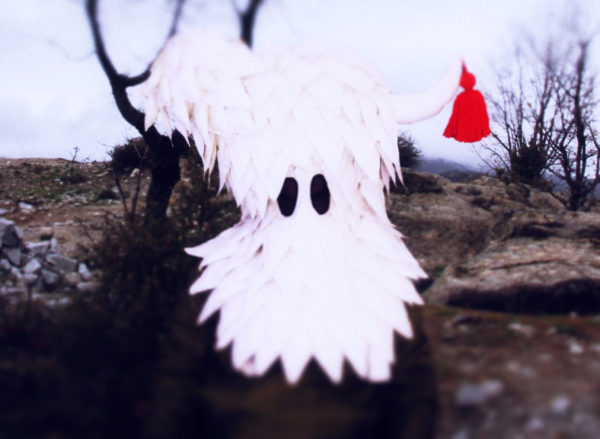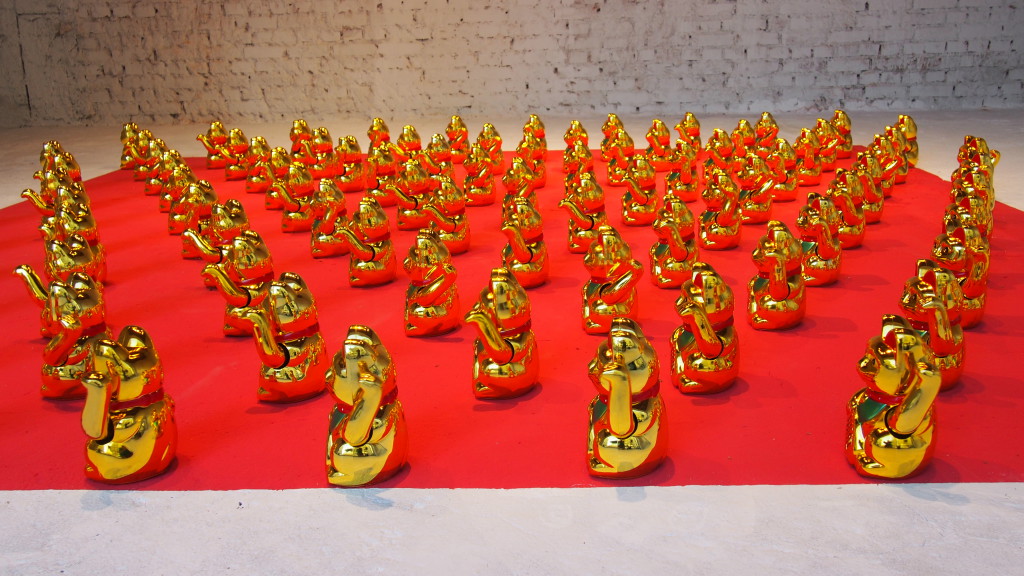Sillyconductor and Rochite are two monikers of the same Romanian artist, Cătălin Matei, living in Bucharest. Sillyconductor excels at the more classical/mathematical side of the imaginary duo: projects such as Ventichitara (a self-made improvisation instrument built from USB fans), 100 Catronomes (a golden rendition of Ligeti’s Poeme Symphonique employing 100 ManekiNeko cats), Symphonic Cowboy (collages of symphonic music played on the Akai MPC sampler) or Pianosaurus, his latest project, which reinforces the liaison between technology, classical music and humour. He was nominated into SHAPE by Rokolectiv Festival.
You have these various musical guises – could you introduce each of them?
Cătălin Matei: Sillyconductor was the first one. It started as a series of sampled collages of bits and pieces from classical music that were played on an MPC and basically became something else. Then I started making soundtracks and installations, programming and other gimmicks that combine classical music/instruments with technology and as soon as I realised that things had gotten too robotic and I was staring at the computer screen for too long, I picked up an acoustic instrument, a toy or some field recording I’d made, put it through effects, recorded a track again and again, trying to make something dancier. That’s how Rochite came into this world.
Rochite was supposed to be a monster with several voices, that’s why my good friend Ioana Nemes, who is no longer in this world, made me this beautiful white mask that has a microphone stuck inside. There was a lot of folk mythology involved and folk sampling as well so we did our research, and got our arsenal of symbols and colours that VJ Dreamrec projects directly onto the mask. So I’m wearing a mask that’s a screen that’s also an instrument. The music is quite dancy, but the instruments involved are often far from being electronic.
What is the relationship between the more conceptual/cerebral and the more emotional/straightforward elements in your music? I guess the dichotomy of Sillyconductor vs Rochite embodies this.
CM: Well, I usually think about the parenthood of a project after it’s done, not before. It’s usually that Sillyconductor is more on the mathematical side of things and it’s quite playful at the same time. Rochite tracks are usually songs that I’ve done instinctively, playing one track after the other and while it’s still playful, somehow in the end it has this darker tone. So it’s basically hours of chopping up and arranging stuff versus just pressing record and losing your mind.
Can you talk about these instruments that you make, such as Ventichitara, 100 Catronomes and Pianosaurus? Is the playful and mechanical element in all of these important to you?
CM: All three of these are Sillyconductor projects. Ventichitara and Catronomes were part of the same improvisation show I did six years ago. Ventichitara is basically a system built out of fans that go through guitar pedals. It was great fun playing with them and I love installations that offer nearly the same degree of control and finesse like an acoustic instrument. Also I loved the contrast between this huge sound, resembling an aerial attack and the delicate little fans, like twisted little flowers, so fragile and sensitive.
Catronomes were, in a way, quoting Ligeti, but in a more contemporary, tongue-in-cheek manner. In ’62, he employed 100 metronomes that were playing at different speeds. I bought 100 golden Chinese cats which are so poorly made that I couldn’t find two that were waving at the same speed. Also, because their paws were stuck in all these weird positions, they were making their own noise, the same clock-like sound like a metronome with only one speed. You can actually listen to a recording here. Initially, I was only interested in the sound, but in time, after seeing them isolated in a shop window, impossible to be heard, I was really interesting to see how different people get different messages just from looking at them, be it politics, sports or music.
Pianosaurus was an experiment into seeing what happens to the tone of an instrument when pushed beyond the human ability to be played. It’s a surround improvisational platform that usually consists of four virtual pianos that I play with the aid of a customised controller. It’s obviously a mechanical super-piano that allows me to improvise and I sometimes let myself be driven by it. Conlon Nancarrow’s mechanical Bosendorfer is obviously the closest sibling but you can only imagine what you can do with software nowadays. A real piano would probably explode at 3000 BPM and often that is the kind of sound that I’m curious about.
You are also interested in manele, a sort of Romanian turbofolk mixed with oriental elements. Can you talk about your fascination as well as its socio-cultural aspects? And also how it inspires you in your own musical production.
CM: I was born in Braila which is in the east of Romania and it used to be under Turkish control for 300 years. The first manele (proto-manele) bands were born here even before the fall of the Communist regime. Being a harbour, it was subjected to all sorts of influences so it was impossible not to have contact with the oriental scene. I love all suburban forms of dance music and I’m always looking for more. I doesn’t matter if they’re South American, the Balkan or Arabic. I love cumbia and kuchek just as much. Speaking about manele, to be honest, most of the time I prefer the Bulgarian counterparts, their time signatures are way more interesting.
Romanian manele is pretty straightforward and lately has become so similar and poppy that I’ve concentrated my interest into two different directions: either digging into the old manele cassette world from the early nineties – unknown gems that were way more soulful and meaningful than the glitzy contemporary ones – and at the same time I’m still looking for recent productions, but not from the famous gods of the genre, but from kids using Fruity Loops and reggaeton samples or people who remix and reinterpret older or newer stuff. I live in an area where these parties are quite common and I can feel that the next generation pays more attention to this really new innocent kid stuff that bears no message but is more fun and DJ friendly.
You mentioned before when we met that Bucharest as a city is an influence, also in terms of the sonic side. Can you talk about it?
CM: Bucharest is a mad, chaotic city. It’s also one of the noisiest places I know. You usually get to hear about 6 different sounds at any time, be it machinery, animal life or humans. The first time I got this idea of counting the number of sounds I ended up with six and from then on I keep doing this experiment to separate and count. It’s a good exercise, as well, for the ear and for the brain because it’s pretty easy to do it with music but with ambiental sounds it’s harder since you tend to get so used to certain sounds that you no longer hear them.
Take sparrows for example. Or crickets, or passing cars, or your computer, or your bulldog. If we wouldn’t be able to ignore sparrows we would get mad, I guess. Despite it being so polluted and crowded here, there are always surprising animal sounds that I hear and often record, like cicadas or rats being hunted by owls. Is it an influence? Probably it is, since my music always comes out really dense with organic and mechanical elements competing for acoustic space. For me it would be unnatural to live in Bucharest and make uplifting ambient or disciplined techno.
You also worked as a journalist writing about animals. Has this had an influence on your artistic work?
CM: I quit journalism about six years ago. Since I got my first writing job at 18, I somehow got to write about whatever I wanted because people thought it was funny. Then, when I had no more ideas and was only recycling old ones, I stopped. These basic skills that I’ve acquired back then are probably useful since I still have to write about my projects now and then, but I don’t necessarily enjoy it. I think music has to be either self-explanatory or just completely opaque. Either way, five or 25 additional lines of text will not make it any better.
What are your upcoming projects?
CM: Yes, more projects than I can think of. I don’t really like to talk about it, I’d rather make it happen and then brag about it. But I’ve started to organise some workshops for kids explaining how electrical current works, making some plants giggle, making sound drawings and so on. For me it’s really easy because I love kids and since my take on music has always been playful, it’s nice to have them along for the ride. They have better ideas than me anyway.
photo 100 Catronomes: Asociatia Ephemair/www.artondisplay.ro

